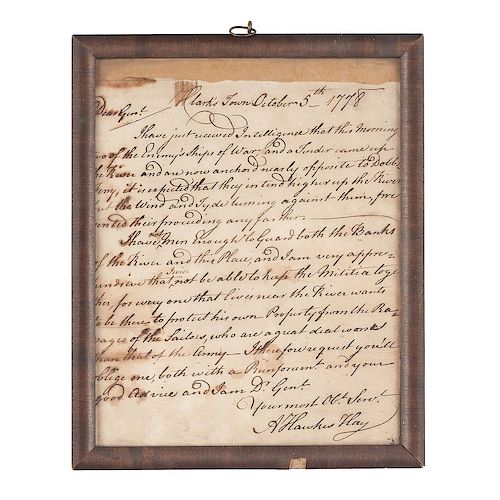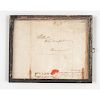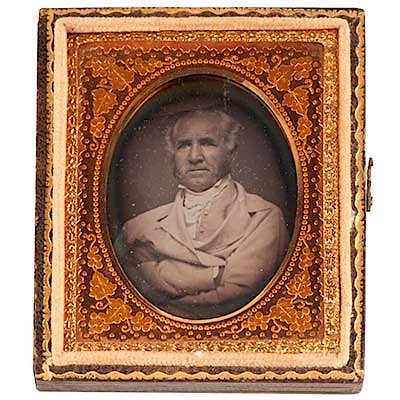Revolutionary War ALS from Col. A. Hawkes Hay to Gen. Wm. Woodford, Regarding the British Navy Threatening New Jersey, 1778
About Seller
6270 Este Ave.
Cincinnati , OH 45232
United States
With offices in Cincinnati, Cleveland and Denver, Cowan’s holds over 40 auctions each year, with annual sales exceeding $16M. We reach buyers around the globe, and take pride in our reputation for integrity, customer service and great results. A full-service house, Cowan’s Auctions specializes in Am...Read more
Two ways to bid:
- Leave a max absentee bid and the platform will bid on your behalf up to your maximum bid during the live auction.
- Bid live during the auction and your bids will be submitted real-time to the auctioneer.
Bid Increments
| Price | Bid Increment |
|---|---|
| $0 | $25 |
| $500 | $50 |
| $1,000 | $100 |
| $2,000 | $250 |
| $5,000 | $500 |
| $10,000 | $1,000 |
| $20,000 | $2,500 |
| $50,000 | $5,000 |
| $100,000 | $10,000 |
About Auction
Nov 16, 2018
Cowan’s Fall American History: Premier Auction features over 200 lots including early photographs, documents, manuscripts, broadsides, flags, and more dating from the Revolutionary War period to the mid-20th Century, many representing important landmark moments in American history. Cowan's Auctions dawnie@cowans.com
- Lot Description
Hay, Ann Hawkes (1745-1785). Colonel in the American Revolutionary War. ALS as Colonel, 2nd Regiment, Orange County, New York Militia, 1p, 6.5 x 7.75 in., framed, 7.75 x 9.5 in., "Clark's Town." October 5th, 1778. Addressed to General William Woodford. Verso with ink inscriptions addressing the letter to "The Honble. / B. Genl. Woodford. / Paramus," and identifying the sender: "From Colo. Hay to / General Woodford . . . / Oct. 5. 1778." Partial red wax seal still affixed to verso.
Hawkes begins the letter by informing Woodford of his latest findings: "I have just received Intelligence that this morning two of the Enemy's ships of War, and a Tinder came up the River and are now anchor'd nearly opposite to Dobbs Ferry, it is expected that they intend higher up the River but the Wind and Tyde turning against them, prevented their proceeding any farther."
He continues by warning Woodford about his potentially perilous situation, writing, "I have not men Enough to Guard both the Banks of the River and this Place, and I am very apprehensive that I will not be able to keep the Militia together, for every one that lives near the River wants to be there to protect his own Property from the Ravages of the Sailors, who are a great deal worse than that of the Army." Hay then closes the letter with a request: "I therefore request you'll oblige me, both with a Reinforcemt. and your good advice and I am D. Genl. / Your most Obt. Servt. / A Hawkes Hay."
William Woodford (1734-1780), a Virginia native, served as a lieutenant in the Cherokee Expedition previous to his service in the Revolutionary War. Serving as a delegate to the Third Virginia Convention as the war approached, Woodford was appointed colonel and placed in command of the 2nd Virginia Regiment, in which capacity he participated in the first significant battle of the war to take place in Virginia. Known as the Battle of Great Bridge, this conflict took place on December 9, 1775, and ended with Woodford driving Lord Dunmore from the Norfolk peninsula, signifying the end of royal authority in Virginia.
Woodford's regiment was ordered to join George Washington's Army in New Jersey in December of 1776, becoming part of the Virginia Line of the Continental Army. Promoted to brigadier general in February 1777, Woodford and his men fought at the Battle of Brandywine, where he was wounded; the Battle of Monmouth, where he crushed the British Army's left flank with artillery; and the Siege of Charleston, where he was captured in 1780 and taken aboard a British prison ship. He died on the ship on November 13, 1780 and was buried at Trinity Church in New York.
Ann Hawkes Hay (1745-1785), a native of Kingston, Jamaica, served as a colonel in the 2nd Regiment of the Organ County, New York militia, in which capacity he observed enemy operations in the Hudson River's Haverstraw Bay. Hay reported to George Washington, detailing the actions of the HMS Phoenix and the HMS Rose, on July 25, 1776, and about enemy operations against Peekskill, New York on March 23, 1777. As a result of British raiders burning down his house and farm in the fall of 1777, Hay went to live in present-day West Haverstraw at his brother-in-law's residence, which also notably served as Washington's headquarters for a short period in July of 1778.
Provenance: From the William Townsend Collection, Helm Place, Lexington, KYLetter with some damp staining, discoloration, creasing, and brittleness at edges. Ink dark and bold. Not examined outside of frame.Condition
- Shipping Info
-
Buyers are required to pay for all packing, shipping and insurance charges. Overseas duty charges are the responsibility of the successful Bidder. Be aware that for larger and/or valuable items, shipping charges can be substantial. - If there is no shipping amount on listed your invoice, you will need to make arrangements to pick up or ship your purchase through an alternative shipping company. Our shipping department can be contacted at 513.871.1670 (ext. 219) or email shipping@cowans.com. - Shipping charges include insurance for your order while in transit. If you have private insurance we will adjust your charge to include only packing and shipping. - Please allow 14 – 21 days after payment to package and ship your purchase as carefully as possible.
-
- Buyer's Premium



 EUR
EUR CAD
CAD AUD
AUD GBP
GBP MXN
MXN HKD
HKD CNY
CNY MYR
MYR SEK
SEK SGD
SGD CHF
CHF THB
THB












